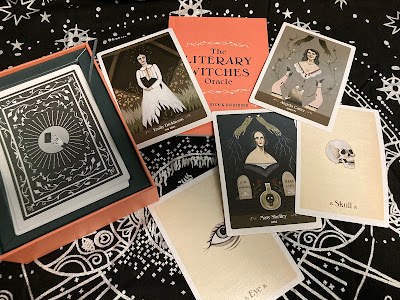Hello everyone! This week on our podcast we are talking about literary witches and literal bitches (boss bitches, that is). Our podcast was inspired by the book Literary Witches A Celebration of Magical Women Writers and the companion oracle deck the Literary Witches Oracle written by Taisia Kitaiskaia and illustrated by Katy Horan.
The book reimagines 30 female authors as “true witches: not hook-nosed creatures riding on brooms, but figures of radical creativity, originality, and empowerment.” Kitaiskaia’s book asks the question “what is a witch anyway?” As we concluded on the podcast, a “witch” doesn’t have to be literal, it can be a strong female that makes “magic” in her everyday life. She can be a catalyst for change both literally and figuratively. She is a true boss that demands change. This book is a perfect homage to these writers and the magic they have written.
The literary aspect and the artwork by Horan initially attracted me to this deck. I am always looking for unique decks to add to my collection and this one does not disappoint. Whenever I find a new deck, I feel like the deck “finds” me. I am usually not explicitly looking for a deck when I see one, and this was the case with my “Literary Witches” deck. I do not generally read from oracle decks, but I felt like I had to have this one, being a lover of literature, especially strong, female authors. The artwork by Horan is nothing less than amazing. I am a huge fan of minimalistic art and I like that her artwork features symbols from the writers’ most famous works. For example, Mary Shelley is a featured writer in the deck/book, and her photo is rich with symbolism from Frankenstein, her most famous piece of work.
Mary Shelley is a great example of a writer that made magic in her lifetime. Shelley wrote Frankenstein when she was only 19 years old while on vacation at her friend Lord Byron’s house on Lake Geneva. The weather was horrible and Byron’s houseguests remained inside most of the time, telling ghost stories. Lord Byron issued a challenge to his houseguests which was to write a ghost story better than the stories they read aloud to each other. Thus, Frankenstein was born and so was the first ever science fiction novel. Over two hundred years after the writing of Frankenstein, Mary Shelley continues to inspire writers and filmmakers alike.
Another example of a writer that made magic in her life is my favorite female poet, Emily Dickinson. Dickinson is considered one of the most important figures in American poetry. Most of Dickinson’s poetry was published posthumously by her sister, and she did not become famous for her writing until after her death. At the time, Dickinson’s poetry was groundbreaking in the sense that she heavily used dashes in her poems and slant rhymes, or near rhymes. Dickinson did not follow traditional poetry rules, and most of her poems were heavily edited to conform to the poetry “rules” of the 19th century. It wasn’t until around the 1950s that Dickinson’s poetry was published in its true form. Dickinson and her “no rules” approach to poetry are now appreciated and serve as inspiration to modern poets that don’t fit with traditional poetry rules and standards.
The final female author that I’d like to talk about is an author I learned about in college: Angela Carter. One of the many English electives I took as I was working on my degree was a fairytale class. Angela Carter’s most famous work is called The Bloody Chamber, a book of fairytales and folktales written with a feminist twist. Like most modern children, I grew up on fairytales, especially the Disney versions of fairy tales where the princess is saved by the prince and they both live happily ever after. In Carter’s versions of fairytales, the female often saves herself by taking a more masculine role or she is the villain all along. In her story “The Werewolf,” which is based on “Little Red Riding Hood,” the wolf turns out to be the grandmother all along and Little Red must save herself from her grandmother. In another version of the story called “Wolf Alice,” Alice (Little Red) herself is the wolf. Carter was innovative in the sense that she opened the door for bolder interpretations of fairy tales, inspiring more modern feminist writers.
Literary Witches: A Celebration of Magical Women Writers is an amazing canonization of female writers. These writers truly created magic in their writing and in their lives and this book is a must-read for anyone looking for inspiration in their writing and their feminist studies. The Literary Witches oracle deck is a must-have for any collection.
I want to hear from our readers. Who is your favorite female writer? Who do you consider a “boss bitch?” Let’s continue the conversation below or on our Facebook Page: MMC Chat.



No comments:
Post a Comment